In the spotlight: QuarkNet
September 29, 2023
Our Rice/UH QuarkNet center made it in this week's QuarkNet Friday Flyer. Take a look at this URL: Friday Flyer Sept.28, 2023 or look at the picture, below.


QuarkMatter 2023
September 04, 2023
The QuarkMatter 2023 conference wrapped up with many group pictures. Below is a small collage of pictures, including Yiding Han's presentation.
Yiding Han's presentation on BES-2 Thermal Dielectron Measurements
Co-chairs of the QuarkMatter conference at The Rustic
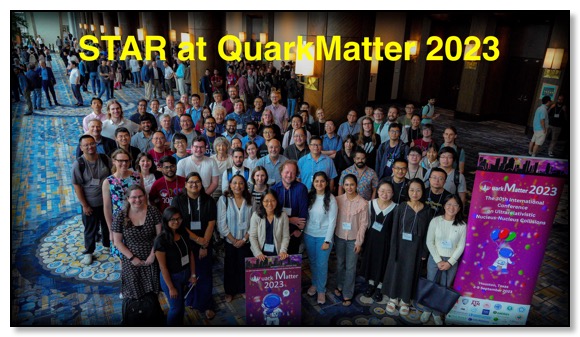
The STAR Collaboration at QM23
Yiding Han's presentation on BES-2 Thermal Dielectron Measurements
Co-chairs of the QuarkMatter conference at The Rustic

The STAR Collaboration at QM23
STAR PreQM'23 Meeting
September 02, 2023
Almost 70 STAR collaborators descended on the Rice campus to participate in the Pre-QuarkMatter meeting. Within a 3-day, jam-packed agenda the collaboration rehearsed all its oral contributions to the QuarkMatter conference, which followed the next week. While outdoor temperatures were consistently about 100F, the campus provided for a welcoming environment in part thanks to the graduate student bar Valhalla and the neighboring Rice Village. Of course, no self-respecting workshop can end without a group picture and below, you'll see an energized STAR collaboration in the Kyle Morrow room on the 3rd floor of the Fondren Library at Rice University. On the big screen you will recognize a few of our online participants, and all the way in the front you can see some of our (very) junior, future collaborators. 😀
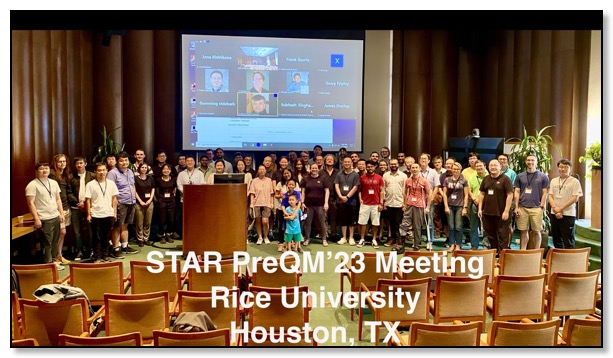

Rice Thresher interview
August 23, 2023
The Rice Thresher is consistently listed in Princeton Review's top-10 of best college newspapers. I was honored to get an online feature. Many thanks to Molly Kyles for a great conversation and her professional work!
https://www.ricethresher.org/article/2023/08/frank-geurts-to-lead-worlds-longest-running-nuclear-collider-experiment
Frank Geurts to lead world’s longest running nuclear collider experiment
By Molly Kyles 8/22/23 11:41pm
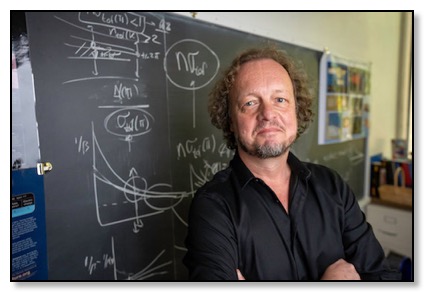
Rice University physicist Frank Geurts has been named co-spokesperson for the Solenoidal Tracker at Relativistic Heavy Ion Collider collaboration, the world’s first heavy-ion collider located at Brookhaven National Laboratory. Alongside Brookhaven Lab physicist Lijuan Ruan, Geurts will lead STAR for the next three years to collect data on nuclear collisions and study the matter that was present at the origin of the universe.
“The neutrons and protons inside atoms melt into their substructure: quarks and gluons,” Geurts said. “We slam nuclei to smithereens and look at what comes out of it. [We] deduce what we had in [early universe] conditions.”
The STAR experiment can replicate the extreme conditions that existed just microseconds after the Big Bang with detailed control over the data collected.
“In the lab, you can have these kinds of collisions many, many times. You can study the conditions and properties created in a lab in a very detailed way,” Ruan said.
For Geurts, these questions surfaced in his life earlier than most. The Netherlands-born scientist can trace his love for physics back to the stars.
“As a kid, I was always very interested in astronomy. I woke up at two o’clock in the morning, looking at the stars,” Geurts said. “The rabbit hole was there, I just went deeper and deeper, and figured that nuclear particle physics was my thing. There was this drive in asking, I went from the large objects in the sky to zooming in and understanding why things are what they are.”
Geurts went on to study physics in his undergraduate and graduate years in the Netherlands. During that time, Geurts had the opportunity to work at CERN, the European Organization for Nuclear Research, before applying for a postdoctoral position at Rice and beginning his involvement with STAR.
“I [selected] Rice because [of] its reputation in designing, development and research in detectors for particle physics,” Geurts said. “I grew into [the STAR] experiment. I was a co-convener, then I was a Physics Analysis Coordinator, then I was a deputy spokesperson and as of recently, I am, together with Lijuan, a co-spokesperson.”
Ramamoorthy Ramesh, Rice’s vice president of research, emphasized the significance of Rice’s affiliation with STAR.
“At the end of the day, you want our faculty to be competing for the biggest discoveries. And the biggest discoveries invariably mean the biggest recognition,” Ramesh said. “We need to be a part of that big conversation, where discoveries are being made.”
Ramesh analogizes the scope of scientific discovery to the vastness of a boba tea shop menu.
“The origins are still being discovered. In the beginning there were just protons, electrons, neutrons,” Ramesh said. “Now, we know there are maybe 33 subatomic particles, with different flavors. It’s exactly like going to a boba tea shop. It’s just tea with boba, but there are 60 different varieties.”
The public funding that the STAR collaboration relies on requires its findings to be communicated to the general public.
“We’re the longest running nuclear colliding experiment. That is, to a substantial degree, thanks to taxpayers. We need to make sure that high school kids, undergrads and middle school [students] know the science so they can have the same enthusiasm we have,” Geurts said.
STAR plans to record its final collisions in 2025, before being converted into an electron-ion collider. However, STAR’s work will continue after its last collision.
“STAR will likely continue another five or eight years just digesting and analyzing,” Geurts said. “We basically redesign a new experiment each time we look at the data.”
From a curiosity in the stars to colliding particles at super speeds, for Geurts, all discoveries come back to collaboration.
“To students that want to make big discoveries, talk about science,” Geurts said. “Discuss it with your peers, with your professors, discuss it with your parents for all I care. Big discoveries come not out of single minds. Big discoveries come out of humans talking to each other.”
https://www.ricethresher.org/article/2023/08/frank-geurts-to-lead-worlds-longest-running-nuclear-collider-experiment
Frank Geurts to lead world’s longest running nuclear collider experiment
By Molly Kyles 8/22/23 11:41pm

Rice University physicist Frank Geurts has been named co-spokesperson for the Solenoidal Tracker at Relativistic Heavy Ion Collider collaboration, the world’s first heavy-ion collider located at Brookhaven National Laboratory. Alongside Brookhaven Lab physicist Lijuan Ruan, Geurts will lead STAR for the next three years to collect data on nuclear collisions and study the matter that was present at the origin of the universe.
“The neutrons and protons inside atoms melt into their substructure: quarks and gluons,” Geurts said. “We slam nuclei to smithereens and look at what comes out of it. [We] deduce what we had in [early universe] conditions.”
The STAR experiment can replicate the extreme conditions that existed just microseconds after the Big Bang with detailed control over the data collected.
“In the lab, you can have these kinds of collisions many, many times. You can study the conditions and properties created in a lab in a very detailed way,” Ruan said.
For Geurts, these questions surfaced in his life earlier than most. The Netherlands-born scientist can trace his love for physics back to the stars.
“As a kid, I was always very interested in astronomy. I woke up at two o’clock in the morning, looking at the stars,” Geurts said. “The rabbit hole was there, I just went deeper and deeper, and figured that nuclear particle physics was my thing. There was this drive in asking, I went from the large objects in the sky to zooming in and understanding why things are what they are.”
Geurts went on to study physics in his undergraduate and graduate years in the Netherlands. During that time, Geurts had the opportunity to work at CERN, the European Organization for Nuclear Research, before applying for a postdoctoral position at Rice and beginning his involvement with STAR.
“I [selected] Rice because [of] its reputation in designing, development and research in detectors for particle physics,” Geurts said. “I grew into [the STAR] experiment. I was a co-convener, then I was a Physics Analysis Coordinator, then I was a deputy spokesperson and as of recently, I am, together with Lijuan, a co-spokesperson.”
Ramamoorthy Ramesh, Rice’s vice president of research, emphasized the significance of Rice’s affiliation with STAR.
“At the end of the day, you want our faculty to be competing for the biggest discoveries. And the biggest discoveries invariably mean the biggest recognition,” Ramesh said. “We need to be a part of that big conversation, where discoveries are being made.”
Ramesh analogizes the scope of scientific discovery to the vastness of a boba tea shop menu.
“The origins are still being discovered. In the beginning there were just protons, electrons, neutrons,” Ramesh said. “Now, we know there are maybe 33 subatomic particles, with different flavors. It’s exactly like going to a boba tea shop. It’s just tea with boba, but there are 60 different varieties.”
The public funding that the STAR collaboration relies on requires its findings to be communicated to the general public.
“We’re the longest running nuclear colliding experiment. That is, to a substantial degree, thanks to taxpayers. We need to make sure that high school kids, undergrads and middle school [students] know the science so they can have the same enthusiasm we have,” Geurts said.
STAR plans to record its final collisions in 2025, before being converted into an electron-ion collider. However, STAR’s work will continue after its last collision.
“STAR will likely continue another five or eight years just digesting and analyzing,” Geurts said. “We basically redesign a new experiment each time we look at the data.”
From a curiosity in the stars to colliding particles at super speeds, for Geurts, all discoveries come back to collaboration.
“To students that want to make big discoveries, talk about science,” Geurts said. “Discuss it with your peers, with your professors, discuss it with your parents for all I care. Big discoveries come not out of single minds. Big discoveries come out of humans talking to each other.”
Team STAR 2nd in the BNL Basketball
July 16, 2023

In addition Kong Tu and Zhengqiao Zhang both from BNL, this STAR-studded team consisted of Rice's own Chenliang Jin and Zaochen Ye!
🏀🏀🏀
Congratulations STAR Team on your 2nd place!!!
🏀🏀🏀
h/t Kong Tu for the picture!
STAR Pre-QM2023 meeting registration is open
July 10, 2023
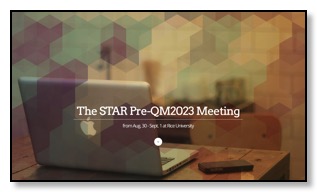
Today the registration of the STAR Pre-QuarkMatter meeting has opened. STAR Collaborators who plan on attending are invited to join this 3-day meeting at Rice University. Collaborators who have been selected to give either oral or poster presentations are strongly encouraged to attend this meeting in person. Information on registration, accomodations, how to get to and around town, and much more can be found at this link https://bit.ly/STARpreQM23
Twitter bird not tweeting ...?
July 10, 2023
Hmm, it looks like the little twitter bird @NuclearRiceU -feature in the right column of this News page- is not tweeting much. Even though it is. This may be another victim of the "turmoil" called Twitter. We'll try to get it back again. (Soon?)
Quick update: embedded twitter feeds are currently all disabled. Even Twitter's own webpages suffer from it: https://developer.twitter.com/en/docs/twitter-for-websites/timelines/overview. With 80% of Twitter's workforce terminated, it's yet to be seen if this feature ever returns, let alone get any priority …
Quick update: embedded twitter feeds are currently all disabled. Even Twitter's own webpages suffer from it: https://developer.twitter.com/en/docs/twitter-for-websites/timelines/overview. With 80% of Twitter's workforce terminated, it's yet to be seen if this feature ever returns, let alone get any priority …
Rice News feature
July 10, 2023
This feature made it to the front page of the Rice website. Many thanks to Silvia Cernea Clark, Gustavo Raskosky, and Brandon Martin for their very professional work!
https://news.rice.edu/news/2023/rice-u-physicist-lead-worlds-longest-running-nuclear-collider-experiment
Rice U. physicist to lead world’s longest-running nuclear collider experiment
Frank Geurts named co-spokesperson of the STAR collaboration
Rice University physicist Frank Geurts is one of two scientists elected to lead the world’s longest-running nuclear physics experiment at a particle collider facility, the Relativistic Heavy Ion Collider (RHIC) at Brookhaven National Laboratory.
Together with Brookhaven Lab physicist Lijuan Ruan, Geurts will serve a three-year term as co-spokesperson for the STAR collaboration. This group of over 740 scientists from 74 institutions across 15 countries uses a 1,200-ton, building-sized instrument ⎯ the Solenoidal Tracker at RHIC, or STAR detector ⎯ to study what happens when gold ions, protons, or a wide range of other atomic nuclei collide into or zoom past each other at ultrahigh speeds.
As co-spokesperson, Geurts will help manage operations for the STAR collaboration and detector system, acting as a representative of its technical and scientific activity.
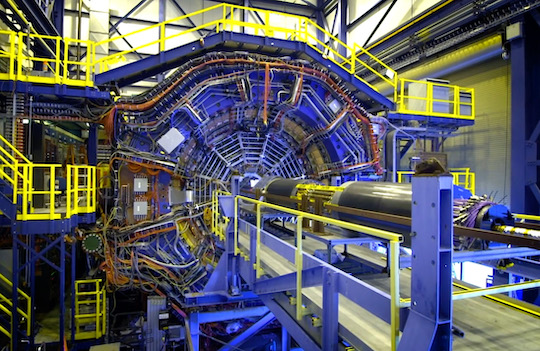
The STAR detector at the Department of Energy’s Brookhaven National Laboratory (Courtesy of Brookhaven National Laboratory)
“We want to make sure that students and institutes across the collaboration can work efficiently with the data collected by the detector and help disseminate our exciting results to the scientific community and the public,” Geurts said.
RHIC, a 2.4-mile-circumference particle accelerator that is the world’s second-largest after the Large Hadron Collider, re-enacts on a subatomic scale cosmic events such as the aftermath of the Big Bang or neutron star collisions. The STAR detector system captures and analyzes data generated by the particle collisions inside RHIC to gain insight into the behavior of nuclear matter under extreme conditions.
“We're investigating very fundamental properties of nuclear matter and the best way to do that is by pushing it to its very extremes,” Geurts said. “Under extreme conditions like the Big Bang, but also when we have neutron star collisions or potentially even in supernovae, nuclear matter can melt into quarks and gluons ⎯ the substructure of these particles.”
Data collected from the collisions offers scientists a snapshot of a primordial state of matter present in the first instants of the universe’s existence known as quark-gluon plasma.
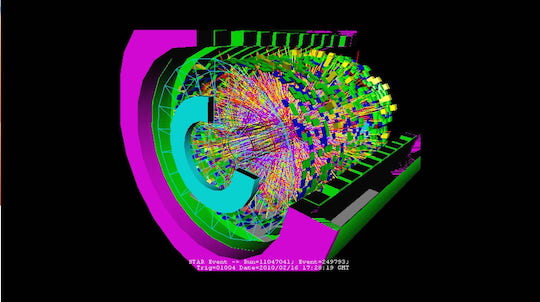
A computer rendering of a collision in the STAR detector (Courtesy of Brookhaven National Laboratory)
“It's basically a soup made up of the particles that form the substructure of protons and neutrons,” Geurts said. “In this soup, these so-called quarks and gluons are effectively liberated, not knowing anymore to what neutron or proton they originally belonged. On top of that, because of the high energies, many more quarks and antiquarks are created in this hot soup. There's a high degree of collectivity in these multiparticle systems.”
Using STAR, scientists learn about difficult-to-study fundamental forces that govern matter in the universe, such as the strong nuclear force. “From early experimental results, we learned that quark-gluon plasma is not so much a hot gas of liberated quarks,” Geurts said. “Instead, it has the characteristics of a hot and strongly interacting fluid with nearly no viscosity, behaving almost like an ideal liquid. This is very interesting, because ⎯ even though we are looking at what is truly the hottest place in the universe ⎯ we find effects of strongly interacting systems that at times look very similar to what you see in matter at ultracold temperatures.”
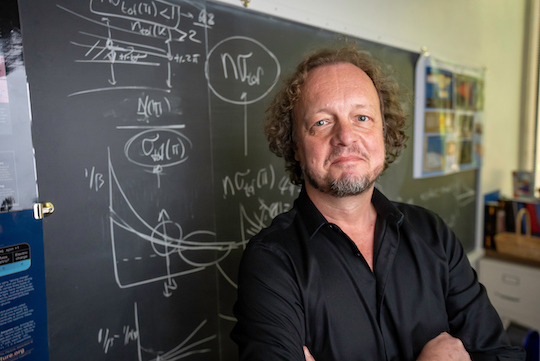
Frank Geurts, a Rice University physics and astronomy professor, has been elected co-spokesperson of the STAR experiment, the world’s longest-running nuclear physics collider experiment at a particle accelerator facility. (Photo by Gustavo Raskosky/Rice University)
The strongest of the four fundamental forces in nature (with gravity, electromagnetism and weak force being the other three), the strong force is what holds matter together both inside and outside the nucleons in atoms.
“Let’s take a gold nucleus, for example,” Geurts said. “You have a lot of neutrons ⎯ which carry no electrical charge ⎯ and protons packed together at the center of an atom. Because protons are positively charged, these particles repel one another, so something else must be way stronger than this electromagnetic force in order to keep them all together. That’s the strong force at work.”
Geurts’ leadership role foregrounds Rice’s long-standing contribution as one of STAR’s founding members. Not only have Rice scientists been actively involved in the collaboration over its near-quarter-century duration, but the university has also helped improve the detector’s particle identification capabilities.
“We can now say with much better precision what kind of particles we see being created in these collisions,” Geurts said.
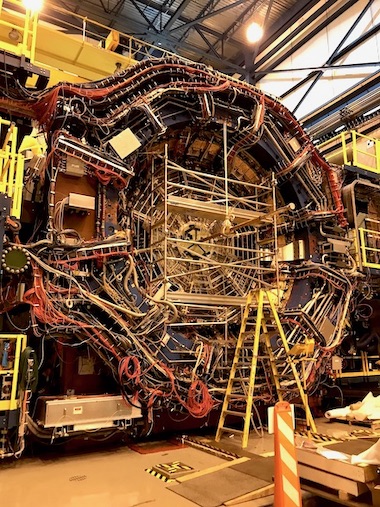
The STAR detector at the Department of Energy’s Brookhaven National Laboratory (Courtesy of Frank Geurts/Rice University)
Geurts, who joined STAR in 2000 as a postdoctoral researcher, highlighted its role as a training ground for generations of scientists.
“We have graduate students who were not born when we started the experiment. We have professors who started their careers as graduate students in this experiment and now are leading new groups throughout the world in this endeavor. The data collected by STAR will continue to serve as an invaluable resource for many more doctoral theses and papers to come.”
Both the detector and the collider are scheduled to run experiments and continue recording data through the end of 2025, after which they will cease operations. Components of RHIC will be transformed into an Electron-Ion Collider, which is expected to begin operation in the early 2030s.
“Our responsibility as a management team is to pave the way for STAR to continue being an innovative and productive scientific enterprise during its post-operational phase,” Geurts said. “We expect that STAR will continue to come up with very exciting science for five, eight, maybe ten years after we record our last heavy-ion collision in 2025.”
src: https://news.rice.edu/news/2023/rice-u-physicist-lead-worlds-longest-running-nuclear-collider-experiment
QuarkNet 2023 Summer Workshop for High-School Teachers
June 03, 2023
In the last week of June, the UH/Rice University QuarkNet Center will hold its annual workshop for high-school teachers. We have a stimulating program thanks to a new collaboration with the IRIS-HEP, we will add a 3-day coding component to our program but also will have sufficient resources to expand the number of teachers that can attend.
In addition to that, we will dedicate a day to the upcoming Worldwide Data Day and learn how to analyze actual data from the CMS detector, and spend another day with "Oopsies in Science" to discuss things that can go wrong in the Edison's "98% perspiration" (which should be contributed to Kate Sanborn.)
We will also feature daily lectures from Rice and UH faculty on a wide range of topics in physics and astronomy.
Look at our agenda (which is still in development) at this link: QuarkNet Summer 2023 Workshop.
Below is the announcement that was sent to the teachers in the Greater Houston Area. There is still some space left, so contact our lead teacher Mary Yarbray if you are a science teacher interested in participating.
Quarknet is a week-long $120/day paid stipend 30-credit hour workshop that allows “teachers and physicists to work together on physics research projects exploring the hidden nature of matter, energy, space, and time”.Quarknet | Our funding and support comes from entities like NSF, University of Notre Dame, Fermilab, and the US Department of Energy.
Who: All secondary science teachers with an emphasis on Physics. This year, we have additional funding from NSF through the Institute for Research and Innovation in Software for High Energy Physics (IRIS-HEP), which allows us to include up to 30 participants this summer. We are interested in reaching out to Houston ISD and Aldine ISD (Title 1 schools), so if you can help spread the word, we would thank you. All Houston area schools are welcome to attend Quarknet.
How teachers can prepare:
Computer, Notebook, writing utensils, and calculators.
Parking:
Parking will be covered by Rice University with a priority to carpools. We usually park in the lot of Rice Blvd and entrance 21.
Class Location: The workshop will take place in Herman Brown Hall room 227. (see agenda for map)
Lunch:
The department of Physics and Astronomy will provide lunch boxes for us. Soda machines may be found about the campus, but you may want to bring extra drinks. The menu is linked to the registration form. If you are bringing your own food, please indicate that on the form.
Agenda: https://star.rice.edu/outreach/quarknet/summer2023/
Introduction to particle physics.
· The first three days (Mon-Wed) will be a coding workshop and the last two days will be filled with a couple of Quarknet activities and preparing for Worldwide Data Day this Fall.World Wide Data Day | Quarknet
· Teachers will need to have a google account with colab access. Colab is not a part of the education suite, so IT might need to flip the switch for it to open. Even then, the district's firewall might still cause issues so please work with your district's IT.
· Fabulous speakers from Rice and UH.
Registration: click here to register.
Thank you for your time,
Dr. Frank Geurts, Rice University Faculty Sponsor
Shane Wood, Quarknet Fellow
Mary Yarbray, Rice University Quarknet Lead Teacher
In addition to that, we will dedicate a day to the upcoming Worldwide Data Day and learn how to analyze actual data from the CMS detector, and spend another day with "Oopsies in Science" to discuss things that can go wrong in the Edison's "98% perspiration" (which should be contributed to Kate Sanborn.)
We will also feature daily lectures from Rice and UH faculty on a wide range of topics in physics and astronomy.
Look at our agenda (which is still in development) at this link: QuarkNet Summer 2023 Workshop.
Below is the announcement that was sent to the teachers in the Greater Houston Area. There is still some space left, so contact our lead teacher Mary Yarbray if you are a science teacher interested in participating.
Quarknet is a week-long $120/day paid stipend 30-credit hour workshop that allows “teachers and physicists to work together on physics research projects exploring the hidden nature of matter, energy, space, and time”.Quarknet | Our funding and support comes from entities like NSF, University of Notre Dame, Fermilab, and the US Department of Energy.
Who: All secondary science teachers with an emphasis on Physics. This year, we have additional funding from NSF through the Institute for Research and Innovation in Software for High Energy Physics (IRIS-HEP), which allows us to include up to 30 participants this summer. We are interested in reaching out to Houston ISD and Aldine ISD (Title 1 schools), so if you can help spread the word, we would thank you. All Houston area schools are welcome to attend Quarknet.
How teachers can prepare:
- A Day with Particles video
- Particle adventure website.
- CMS Experiment video
- The Large Hadron Collider (LHC), video
Computer, Notebook, writing utensils, and calculators.
Parking:
Parking will be covered by Rice University with a priority to carpools. We usually park in the lot of Rice Blvd and entrance 21.
Class Location: The workshop will take place in Herman Brown Hall room 227. (see agenda for map)
Lunch:
The department of Physics and Astronomy will provide lunch boxes for us. Soda machines may be found about the campus, but you may want to bring extra drinks. The menu is linked to the registration form. If you are bringing your own food, please indicate that on the form.
Agenda: https://star.rice.edu/outreach/quarknet/summer2023/
Introduction to particle physics.
· The first three days (Mon-Wed) will be a coding workshop and the last two days will be filled with a couple of Quarknet activities and preparing for Worldwide Data Day this Fall.World Wide Data Day | Quarknet
· Teachers will need to have a google account with colab access. Colab is not a part of the education suite, so IT might need to flip the switch for it to open. Even then, the district's firewall might still cause issues so please work with your district's IT.
· Fabulous speakers from Rice and UH.
Registration: click here to register.
Thank you for your time,
Dr. Frank Geurts, Rice University Faculty Sponsor
Shane Wood, Quarknet Fellow
Mary Yarbray, Rice University Quarknet Lead Teacher
GRASP Workshop and the connection between Rice and Utrecht
May 23, 2023
This week the Institute for Gravitational and Subatomic Physics, cleverly abbreviated to GRASP, holds its inaugural workshop. GRASP, formally known as SAP (you can guess what that stands for), previously known as Vakgroep Kernfysica, is a research institute within Utrecht University's Departement Natuurkunde (Physics Department).
Its history is impressive, going back to people like Ornstein at a time when the department was still situated in the old city center of Utrecht at the Bijlhouwerstraat, built in 1875 upon insistence by Buys Ballot (who was a meteorologist with a remote interest in experimental physics). There is much more to read about this beautiful building at this link. What is interesting is to read the comments by Prof. Jan Kuperus: unbeknown to me and likely many people that walk in the park on top of it, the lab hosted a small particle accelerator. Raimond Snellings delivered a great historical account in his opening talk.
The GRASP Opening Workshop was held in yet-another-impressive building in the old inner city of Utrecht: the Paushuis, a building built in the early 16th century for the Dutch pope to live. But never ended up doing so. Ah well, a great place for a very informative workshop on the aspects of gravitational waves and heavy-ion physics, the two main pillars of the GRASP institute.
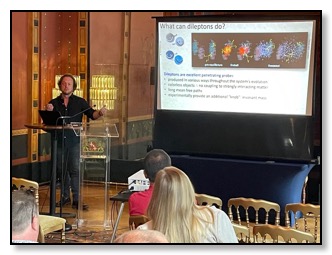
Its history is impressive, going back to people like Ornstein at a time when the department was still situated in the old city center of Utrecht at the Bijlhouwerstraat, built in 1875 upon insistence by Buys Ballot (who was a meteorologist with a remote interest in experimental physics). There is much more to read about this beautiful building at this link. What is interesting is to read the comments by Prof. Jan Kuperus: unbeknown to me and likely many people that walk in the park on top of it, the lab hosted a small particle accelerator. Raimond Snellings delivered a great historical account in his opening talk.
The GRASP Opening Workshop was held in yet-another-impressive building in the old inner city of Utrecht: the Paushuis, a building built in the early 16th century for the Dutch pope to live. But never ended up doing so. Ah well, a great place for a very informative workshop on the aspects of gravitational waves and heavy-ion physics, the two main pillars of the GRASP institute.

Run 23 cooldown finished
May 13, 2023
Run 23 is about to start. Its overall length is determined by the number of so-called cryoweeks; or, the number of weeks that the superconducting magnets are in operating conditions, i.e. below 4.6K. This important milestone was set to happen for May 11, and in the figures you can indeed see that from the ambient, "room" temperature throughout the early part of the spring cooling with liquid nitrogen brought the magnets down to about 60-80K, followed by the final step which involves liquid helium. 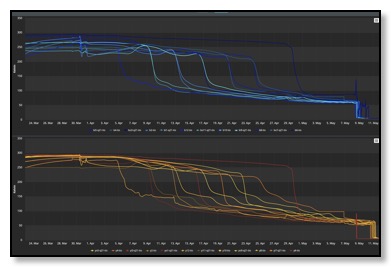
The graphs, which anybody can follow from CAD's website, show that the blue beam (which runs clockwise) was the first to reach this milestone, followed by the yellow beam (which runs counterclockwise).
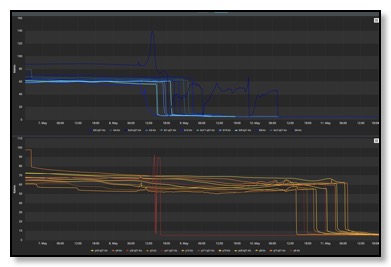
Zooming in, above, on the last days as the blue ring drops first to operating temperatures, followed by the supercolliding magnets of the yellow beam. Below, zooming in even a bit more to the May-11 start of cryo-weeks, you can now see the blue-ring temperatures hover around and below 4.8K
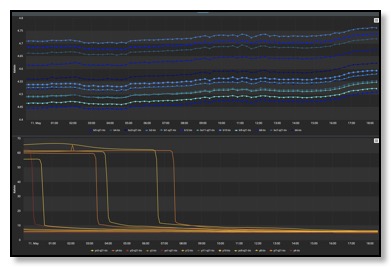

The graphs, which anybody can follow from CAD's website, show that the blue beam (which runs clockwise) was the first to reach this milestone, followed by the yellow beam (which runs counterclockwise).

Zooming in, above, on the last days as the blue ring drops first to operating temperatures, followed by the supercolliding magnets of the yellow beam. Below, zooming in even a bit more to the May-11 start of cryo-weeks, you can now see the blue-ring temperatures hover around and below 4.8K

May The Fourth Be With You
May 04, 2023
#TBT May 4th, 2018, at the #STAR Control Room, view from the Shift Leader's desk waiting for beam …
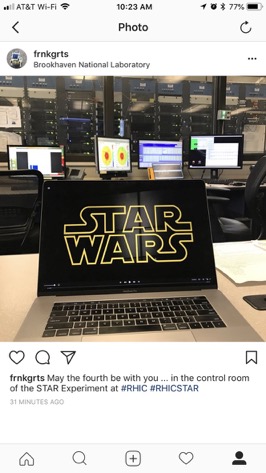

A Spokesperson's Welcome
May 01, 2023
Starting today, May 1, I will join Lijuan in our new co-spokespersons' team of the STAR Collaboration. Earlier today, we made the following announcement to the collaboration. We are excited to work with our new management team and very grateful to an excellent team that got us where we are. Those are big shoes to fill!
This morning the outgoing and incoming management teams held their last joint management meeting. As we announced to Council, starting today, May 1, the new management team will take on its responsibilities. Before introducing the new team to you, we’d like to take this opportunity to express on behalf of the Collaboration our sincere gratitude to all the members of the old team who have dedicated so much of their time in the past years to help steer our collaboration through BES-2, the forward upgrades, and have now put us in the best position to run for three more years at top energies.
Please join us in thanking Helen, Ken, Xin, Rongrong, and Takafumi !!
With the transition now complete [1], Lijuan and I would like to introduce the new management team. We have included their email address and would like to ask you to direct your management queries to them.
Spokesperson: Lijuan Ruan (BNL, ruan@bnl.gov)
Spokesperson: Frank Geurts (Rice University, geurts@rice.edu)
Deputy Spokesperson: ShinIchi Esumi (University of Tsukuba, esumi.shinichi.gn@u.tsukuba.ac.jp)
Deputy Spokesperson: Qinghua Xu (Shandong University, xuqh@sdu.edu.cn)
Physics Analysis Coordinator: Sooraj Radhakrishnan (Kent State University, skradhakrishnan@lbl.gov)
Deputy Physics Analysis Coordinator: Barbara Trzeciak (Czech Technical University, barbara.trzeciak@gmail.com)
Best regards,
Frank & Lijuan
[1] https://www.star.bnl.gov/welcome.php
This morning the outgoing and incoming management teams held their last joint management meeting. As we announced to Council, starting today, May 1, the new management team will take on its responsibilities. Before introducing the new team to you, we’d like to take this opportunity to express on behalf of the Collaboration our sincere gratitude to all the members of the old team who have dedicated so much of their time in the past years to help steer our collaboration through BES-2, the forward upgrades, and have now put us in the best position to run for three more years at top energies.
Please join us in thanking Helen, Ken, Xin, Rongrong, and Takafumi !!
With the transition now complete [1], Lijuan and I would like to introduce the new management team. We have included their email address and would like to ask you to direct your management queries to them.
Spokesperson: Lijuan Ruan (BNL, ruan@bnl.gov)
Spokesperson: Frank Geurts (Rice University, geurts@rice.edu)
Deputy Spokesperson: ShinIchi Esumi (University of Tsukuba, esumi.shinichi.gn@u.tsukuba.ac.jp)
Deputy Spokesperson: Qinghua Xu (Shandong University, xuqh@sdu.edu.cn)
Physics Analysis Coordinator: Sooraj Radhakrishnan (Kent State University, skradhakrishnan@lbl.gov)
Deputy Physics Analysis Coordinator: Barbara Trzeciak (Czech Technical University, barbara.trzeciak@gmail.com)
Best regards,
Frank & Lijuan
[1] https://www.star.bnl.gov/welcome.php
QuarkNet Masterclass 2023
March 27, 2023
On Saturday, March 23, we welcomed more than 30 students and teachers from 8 high schools on our campus for the annual QuarkNet Master Class. Starting at 8h30am, we had a full day with a wide range of activities culminating in a Zoom call with particle physicists at Fermilab (Chicago) and other schools in Oklahoma to discuss the results of our hands-on analyses of real CMS data.
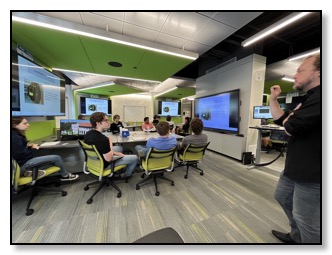
The morning started with an exercise in which we tried to organize a card deck with many fundamental particles. What organizational principle would you choose? And why? Mass, charge, spin, year of discovery? Darin Acosta (the leader of a similar QuarkNet program at the University of Florida) explained in his presentation how physicists now believe the Standard Model provides a good description of our current understanding of fundamental particles. But, quoting Darin here, "who knows what this will look like 100 years from now?"
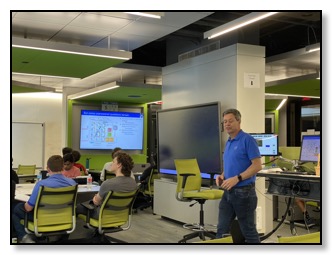
Talking about particles is one thing, "seeing" them is a whole other endeavor. In the advanced teaching lab located in Brockman Hall 120, graduate student Jaanita Mehrani demonstrated the workings of a real scintillator-based cosmic ray detector similar to what many schools operate through the QuarkNet CRD program. She also demoed a very small, ultra-portable cosmic ray "watch." She allowed the students to peak at an ongoing physics experiment in which junior undergraduate students measured the lifetime of muons. A Cloud Chamber, located in a dark area of the lab, gave a real sense of muons passing through, as well as other particles, each leaving their signature trails.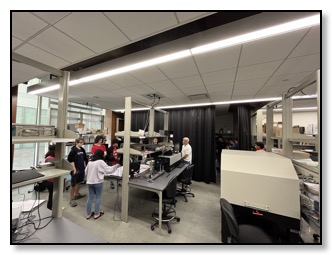
More lectures on what it takes to actually measure particles were followed by two more lab tours and a boxed lunch, kindly provided by the Department of Physics & Astronomy.
The two tours took the students and teachers to the labs of Dr. Morosan and Dr. Killian (Dean of Natural Sciences). In Dr. Morosan's lab the students experienced the wondrous world superconducting materials that under very cold conditions will levitate. In Dr. Killian's lab carefully tuned lasers were able to almost stop atoms from vibrating thus creating the literally coolest place in the universe (yes, outer space is on average almost a million times hotter!)
After about an hour of actual physics analyses of real CMS data, all students joined a Zoom meeting with another school in Oklahoma analyzed at the same time ATLAS data and a panel of expert physicists at Fermilab in Chicago.
The agenda, links to resources that we used, and some more pictures can be found at this 2023 MasterClass's page.

The morning started with an exercise in which we tried to organize a card deck with many fundamental particles. What organizational principle would you choose? And why? Mass, charge, spin, year of discovery? Darin Acosta (the leader of a similar QuarkNet program at the University of Florida) explained in his presentation how physicists now believe the Standard Model provides a good description of our current understanding of fundamental particles. But, quoting Darin here, "who knows what this will look like 100 years from now?"

Talking about particles is one thing, "seeing" them is a whole other endeavor. In the advanced teaching lab located in Brockman Hall 120, graduate student Jaanita Mehrani demonstrated the workings of a real scintillator-based cosmic ray detector similar to what many schools operate through the QuarkNet CRD program. She also demoed a very small, ultra-portable cosmic ray "watch." She allowed the students to peak at an ongoing physics experiment in which junior undergraduate students measured the lifetime of muons. A Cloud Chamber, located in a dark area of the lab, gave a real sense of muons passing through, as well as other particles, each leaving their signature trails.

More lectures on what it takes to actually measure particles were followed by two more lab tours and a boxed lunch, kindly provided by the Department of Physics & Astronomy.
The two tours took the students and teachers to the labs of Dr. Morosan and Dr. Killian (Dean of Natural Sciences). In Dr. Morosan's lab the students experienced the wondrous world superconducting materials that under very cold conditions will levitate. In Dr. Killian's lab carefully tuned lasers were able to almost stop atoms from vibrating thus creating the literally coolest place in the universe (yes, outer space is on average almost a million times hotter!)
After about an hour of actual physics analyses of real CMS data, all students joined a Zoom meeting with another school in Oklahoma analyzed at the same time ATLAS data and a panel of expert physicists at Fermilab in Chicago.
The agenda, links to resources that we used, and some more pictures can be found at this 2023 MasterClass's page.
Spring '23 STAR Collaboration Meeting
March 04, 2023
I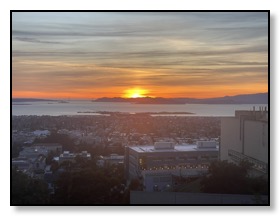 t's been a while since I attended a STAR Collaboration meeting in person, let alone visited Berkeley's LBNL. In fact, I was looking forward to visiting LBNL back in March 2020 when COVID reared its ugly head. At that time, it had already been more than 3 years since my last trip to LBNL. A rather memorable meeting that took place in the wake of a rather dramatic US presidential election. I am digressing. It was good to be back in Berkeley again and meet with friends and colleagues, and sunsets across the Bay are still impressive, even in cloudy conditions.
t's been a while since I attended a STAR Collaboration meeting in person, let alone visited Berkeley's LBNL. In fact, I was looking forward to visiting LBNL back in March 2020 when COVID reared its ugly head. At that time, it had already been more than 3 years since my last trip to LBNL. A rather memorable meeting that took place in the wake of a rather dramatic US presidential election. I am digressing. It was good to be back in Berkeley again and meet with friends and colleagues, and sunsets across the Bay are still impressive, even in cloudy conditions.
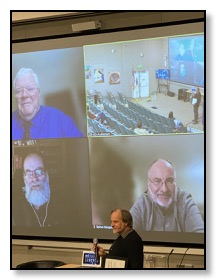 Among the many physics discussions, a few items stood out. The STAR Juniors coordinated lunch parties with senior scientists. My lunch with students from Yale, UC Riverside, and CTU was an absolute delight and I hope these lunches will become a staple in future meetings. Another important event was the opportunity we had as a collaboration, but also as individuals to bid one of our most esteemed colleagues and long term STAR collaborator, Bill Christie a happy start of his retirement. I particularly like the picture in which you can see Bill holding a certificate under the watchful eyes of Tim Hallman (Assoc. Director DOE Office of Nuclear Physics), Spyros Margetis (DOE/NP Prog.Director), and Flemming Videbaek (BNL/STAR retiree). Bill's commitment to STAR serves as an excellent example to all of us - somebody who I have called at early hours from the STAR Control Room, or often somebody who'd be calling me asking why we weren't taking data.
Among the many physics discussions, a few items stood out. The STAR Juniors coordinated lunch parties with senior scientists. My lunch with students from Yale, UC Riverside, and CTU was an absolute delight and I hope these lunches will become a staple in future meetings. Another important event was the opportunity we had as a collaboration, but also as individuals to bid one of our most esteemed colleagues and long term STAR collaborator, Bill Christie a happy start of his retirement. I particularly like the picture in which you can see Bill holding a certificate under the watchful eyes of Tim Hallman (Assoc. Director DOE Office of Nuclear Physics), Spyros Margetis (DOE/NP Prog.Director), and Flemming Videbaek (BNL/STAR retiree). Bill's commitment to STAR serves as an excellent example to all of us - somebody who I have called at early hours from the STAR Control Room, or often somebody who'd be calling me asking why we weren't taking data.
Oh, and then there was one more important item that had to be decided by the STAR Council at this collaboration meeting and that was the election of the next co-spokespersons. I am thankful to the Council for the trust that they put in Lijuan Ruan (BNL) and me to lead the STAR collaboration for the next three years.


Oh, and then there was one more important item that had to be decided by the STAR Council at this collaboration meeting and that was the election of the next co-spokespersons. I am thankful to the Council for the trust that they put in Lijuan Ruan (BNL) and me to lead the STAR collaboration for the next three years.
